With the right SEO strategy in place, fitness centers, gym owners, and personal trainers can increase organic visibility for their websites on search engines like Google, Yahoo, and Bing to attract more clients and memberships for their businesses.
This guide explains the fundamentals of how to do SEO for fitness websites and gyms from start to finish. It also includes a list of keyword ideas to target and the most searched topics in the fitness industry so you can easily generate content ideas for your website.
SEO for Fitness Websites & Gyms Strategy Guide
1. Choose the Right SEO Keywords
The first step in optimizing your fitness website for SEO is to create a list of keywords that are related to your particular business.
If you’re trying to attract local clients or new members, then you’ll want to focus on keywords that include your local area. For example, “fitness center in Baltimore”, “yoga studio in Cambridge”, “Crossfit gym in Barton”, or “Scottsville Zumba classes”.
If you’re trying to attract fitness or gym members on a national or international level, then you can target general keywords in the fitness niche. For example, “online fitness program”, “Pilates training coach”, “wholesale gym equipment”, or “Daily Burn workouts at home”.
One of the best keyword research tools for this process is KWFinder by Mangools (try it for free). It’s one of the only SEO tools I recommend as an affiliate because it’s a cheap, yet powerful tool for keyword research.
The Mangools suite of tools also comes with other great things like a Keyword Rank Tracker, Backlink Miner, and Site Profiler. And, in my opinion, there’s no other tool you need to be successful with SEO for gyms and fitness websites.
Here’s a quick demo of how the KWFinder keyword research tool works:
In KWFinder, you can search for a seed keyword like “boxing gyms in Maryland” and the tool will show you related keyword phrases along with the average monthly search volume and keyword difficulty score (more on this SEO metric later).
In the image below, you can see suggested keywords like “boxing gym Baltimore”, Knockout fitness Baltimore”, “boxing classes in Maryland”, “boxing gym Annapolis”, and many more.
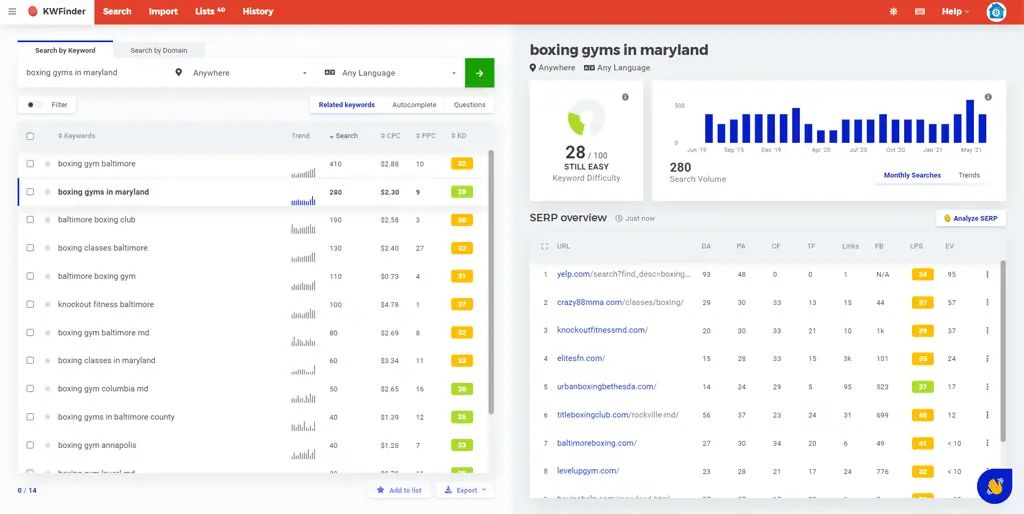
Whenever you see a green-colored square under the KD (Keyword Difficulty) column, that means the keyword phrase is easy to target. As a fitness center, gym, workout studio, or personal trainer, you should be looking for keywords with high search volume and low keyword difficulty to write content on for your website.
By following this SEO strategy for keyword selection, you can achieve faster ranking results in Google, Yahoo, and Bing than if you were to go after more difficult terms with high KD scores.
Another thing to keep in mind here when creating your final list of SEO keywords is that it’s best to cluster the closely related keywords together so you can target them all on one page. You do not want to create two or more separate pages for keywords that target close variations or attract the same type of fitness client or gym member.
For example, you wouldn’t write a separate piece of content for “boxing gym in Baltimore” and “boxing gyms in Baltimore County” even though these two keyword phrases show up in a keyword research tool like KWFinder. Both of those keyword phrases belong on the same page. Similarly, keyword phrases like, “online Zumba classes” and “virtual Zumba classes” belong on the same web page; not as separate pieces of content.
Fitness & Gym SEO Keyword Ideas
| Seed Keyword Idea | SEO Keyword Examples |
|---|---|
| “Fitness Center” + [Your Local Area] | Fitness Center in Danville, VA |
| [Your Local Area] + “Gym or Fitness Center” | Barton, NY Gym |
| [Excercise Type] + [Your Local Area] | Bodypump in Madison, WY |
| [Excercise Type] + “Class or Classes” + [Your Local Area] | Kickboxing Classes in Harfield, MD |
| [Excercise Type] + “Class or Classes” + [Person Type] + [Your Local Area] | Pickleball Classes for Older Adults in Sandy, UT |
Note: These SEO keywords are general ideas for fitness and gym websites. You can mix and match the examples and use other words that apply to your particular fitness center, gym, or studio.
More Keywords That Relate Fitness Centers & Gyms
- aerobics
- athletic training
- basketball court
- bodybuilding
- diet
- exercise
- fitness training
- gym
- health and wellness
- older adults
- pickleball
- pool
- shape
- seniors
- studio
- students
- tennis
- weight lifting
- workout program
2. Optimize Your Fitness Website for SEO
After you have a good list of keywords to target, the next step for fitness SEO is to optimize your website for your target phrases. As previously mentioned, the best way to do that is to create individual pages for the keyword clusters you’re focusing on. That way, you can optimize the content so it can rank for all of the related terms and capture the most amount of traffic.
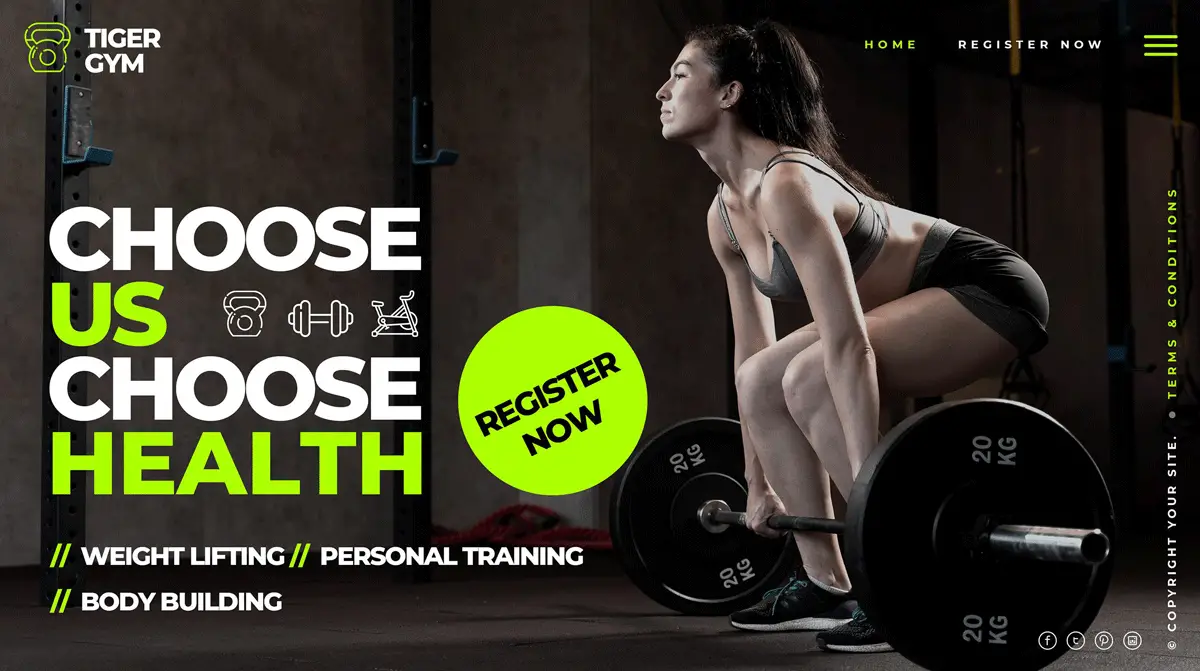
Now, there are about 20 HTML locations you can optimize a financial advisor website for SEO, but the 5 elements listed below are the best places for you to get started. By optimizing these locations the right way, you’ll give your content a better chance at ranking on the first page of Google without having to worry as much about the other 15 spots.
Note: If you want a comprehensive guide on on-page optimization for advanced SEO training, then check out the Complete On-Page SEO Checklist.
Meta Title Tags
The meta title, also known as the title tag, is one of the most important ranking factors for on-page SEO. Meta title tags tell Google what the page content is about and get displayed in the search results for your website listings. Therefore, the keywords you put in this HTML field are crucial for higher rankings.
If you have an SEO plugin installed on your site, then you can easily edit the title tag for your web pages to include your target keywords. All-In-One SEO, Yoast, and RankMath are good options for this purpose.
The best way to optimize the meta title tag is to put your main target keyword at the beginning of the page title so it appears first in Google’s search engine. This position also has the most SEO weight for rankings.
Here’s an example of a good meta title tag that’s optimized for the keyword phrase, “Pilates studio in Destin”.
- Title Tag: Pilates studio In Destin, FL (Individual & Group Classes)
You can also look at the top 5 ranking pages in Google for your target keyword phrase to get ideas on how to write a well-optimized title tag. The top-ranking pages are clearly optimizing this HTML field correctly, otherwise, they would not be ranking so high in Google’s search engine.
Meta Descriptions
The meta description is another field you can optimize with an SEO plugin. Meta descriptions give Google, Yahoo, and Bing a brief summary of what the page content is about. Meta descriptions are also displayed under your web page listings in the search results when they best match the user’s query.
A simple gym and fitness SEO tip here is to include your main target keyword as the first piece of text in the meta description. Then, include as many secondary keywords as you can without repeating too many of the same words or making it sound unnatural.
Here’s an example of a meta description that is properly optimized for the keywords “senior fitness center in New York”, “senior fitness center NYC”, and “fitness center for older adults in NYC”.
- Meta Description: Voted BEST senior fitness center in New York City. Participate in group fitness lessons, tennis, yoga, pickleball, and more with other older adults in NYC.
If you need additional help optimizing the meta description for a target page, follow the previous advice about doing a Google search for the main keyword phrase. The meta descriptions for the top 5 ranking pages on Google will help guide you on the word order and choices to include in this HTML element.
Page URLs
The page URL is another important ranking factor for fitness websites and gyms. Page URLs are the string of text that appears in the search bar and point to a particular page on the site. Google also displays a portion of this URL in the SERPs. Therefore, it’s good to have your main keyword as the URL.
You also want to use dashes (-), not underscores (_) between words in the URL. Google doesn’t recognize underscores as word separators and that can harm your SEO efforts on a fitness or gym website.
For example, the URL for this SEO guide is:
- /seo-for-fitness-websites/
Now, if you were creating a web page for a specific fitness class, gym workout program, or personal training session, then the URL structure should contain the primary keyword phrase and the location.
For example, a page targeting the keyword phrase, “Zumba classes in West Hollywood” could look like this:
- /zumba-classes-in-west-hollywood/
Headers
The headers for a web page include the H1 to H6 tags. The H1 heading is usually coded in HTML as the visible page title for the reader. A good rule of thumb for SEO is to copy the title tag text into the H1 heading so they are duplicates of each other.
For example, the meta title tag mentioned in our previous example for meta title tags could be copied into the H1 heading for the page so it looks like this:
- H1 Heading: Pilates Studio In Destin, FL (Individual & Group Classes)
The H2 to H6 tags are used to outline the content for the reader. H2s are the main subheadings, while H3s are subheadings under H2, and so forth down the line to H6.
When implementing SEO for gyms and fitness sites, you want to put your main keyword for the web page in the first H2 subheading and then try to include secondary keywords in subsequent H2 tags in a natural way if you have any to target.
For example, a personal trainer page targeting the keyword phrases “personal trainer cost in Miami” and “hourly rate for a personal trainer in Miami” could optimize two H2 subheadings on the page like this:
- H2 Subheading: Average Personal Trainer Cost In Miami
- H2 Subheading: Hourly Rate for a Personal Trainer In Miami at Our Gym
If your content has any H3 subheadings, you can put keyword variations and partial-match keyword phrases in this HTML tag to help boost the on-page SEO signals without over-optimizing the target keywords.
For example, the following text could be placed in H3 subheadings for the “Average Personal Trainer Cost In Miami” H2 section to bolster on-page relevance:
- H3 Subheading: Low-End Cost for a Personal Trainer
- H3 Subheading: High-End Cost for a Personal Trainer
- H3 Subheading: Average Price Per Month
As for the H4 to H6 tags, these HTML elements can be ignored for on-page SEO as they don’t have as much influence on search engine rankings. You can choose to use them, if needed to outline the content for the reader, or ignore them without any worries about the impact for SEO.
Navigation Menu
The navigation menu can also be optimized for SEO purposes on a fitness website. Not only does this menu help visitors navigate your site but it also tells Google what the most important pages are for your visitors, and therefore, should rank the highest in the search results.
To use this SEO strategy, simply place a link in the navigation menu with keyword-optimized anchor text for the seed keyword phrase. You don’t need to go overboard by adding the exact match phrase with your target state or city location because the content on the target page and the rest of the website will already contain that information.
For example, if you were targeting the keyword phrases “aerobic exercise center in Fort Worth”, “Jazzercise fitness classes in Forth Worth”, and “yoga studio in Forth Worth, then a good set of anchor text links for the navigation menu would be:
- Aerobic Exercise Center
- Jazzercise Fitness Classes
- Yoga Studio
3. Set Up A Google Business Profile
Creating a Google Business page listing is crucial for fitness centers and gyms with a physical location. Having a physical location listed on a verified Google Business Profile will help your fitness organization be better optimized for local searches that include your city or town name as well as “near me” searches.
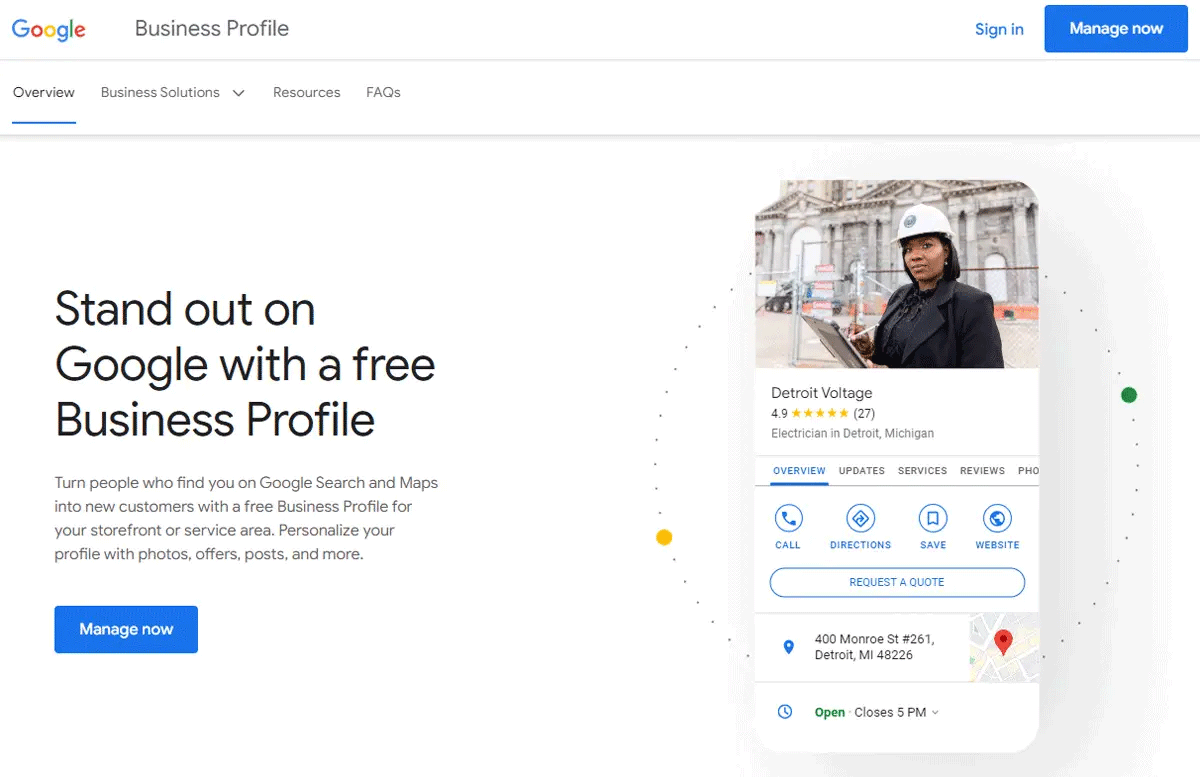
For local businesses, a Google Business Profile listing ensures your business also shows up in the Google Map Pack in the search engine. The Google Map Pack is a search results feature that enables users to quickly identify the most relevant businesses that provide what they searched for. This feature includes the top three business listings that Google’s system determines is the most relevant for the searcher.

A Google Business Profile allows you to include photos, hours, fitness activities, contact information, and reviews, so it’s beneficial for more than just SEO purposes. Google Business Profiles also help to attract new clients and members to your exercise facility.
Follow these best practices to optimize your Google Business Profile for local SEO:
- Set Up a Google Business Profile: Go to google.com/business/.
- Complete All Information Fields: Fill out as much information as possible for your business listing, including the physical address, phone number, and category. The more information you include, the easier it is for Google to match your business with relevant keyword searches.
- Put Relevant Keywords In the Business Description: Adding relevant keywords for your gym and fitness center offerings in the business description can help Google match your listing to more local searches.
- Include Your Business Hours: List your hours of operation for each day of the week. Also, update your listing to include holiday hours as the approach. This improves the reliability of your Google Business Profile which can help improve visibility during certain times of the year.
- Add Photos: Photos are an essential element for fitness and gym SEO on Google Business. Uploading photos to your Profile helps show off your building so potential clients will want to visit your location and know that they’re in the right place upon arrival. You can also add images of your facility, exercise equipment, group training sessions, etc, to get people excited about visiting your fitness center.
- Verify Your Location: Verification is essential for proving your business is located where you say it is. A verified location on Google Business increases your chances of showing up on Google Search and Google Maps.
- Get Reviews: Gyms and fitness centers that have the most positive reviews tend to rank higher on Google Search and in the Map Pack. You should share your Google Review link with current clients and members encouraging them to leave a review of your facility or training services. (More details with screenshots below.)
- Create Optimized Google Posts: Google lets you create posts that appear on your Google Business Profile for new offers, company updates, and events. Each time you create a new post, make sure to add relevant keywords to the content. That way, you can keep your Google Business Profile optimized for the phrases and terms that matter most for attracting the right fitness clients and gym members.
Following these tips will improve the basic optimization of your Google Business Profile. For more advanced SEO tips, check out our Google Business Optimization Checklist and this dedicated guide on How to Add Keywords to a Google Business Profile.
Getting Your Google Review Link to Share with Others
- Go to your Google Business Profile.
- Click the “Ask for Reviews” button.
- Click the review link to copy it.
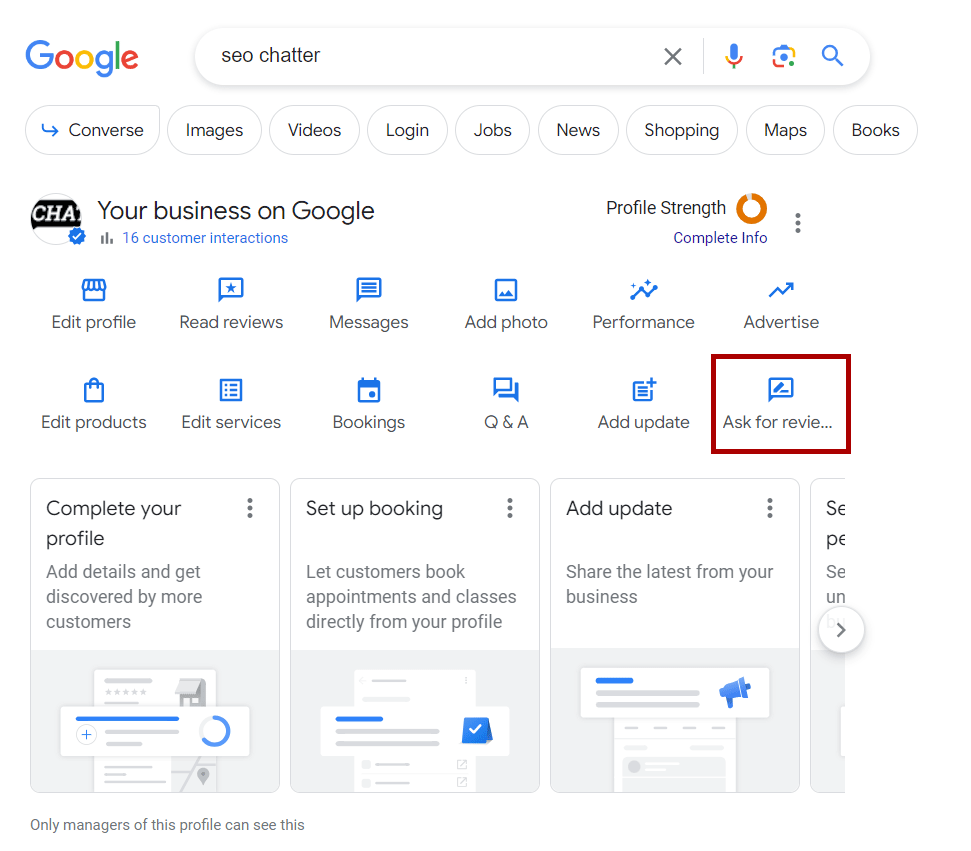
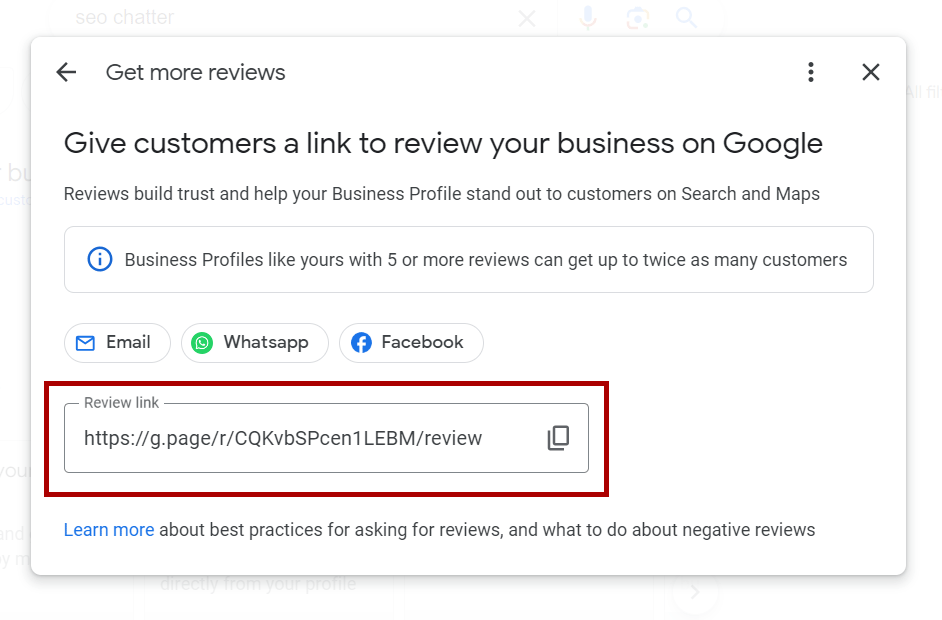
Another important tip here is to respond to all Google reviews your business listing receives. If a person leaves a review, make sure to immediately respond to it; regardless if it’s a good or bad review. This demonstrates to potential members or training clients that you are active on the Google Business platform and care about your members’ experiences. Some SEO experts also believe that this interaction with reviewers helps boost visibility for the listing in local search results.
4. Add NAP and Schema Markup to Your Website
NAP refers to the name, address, and phone number of a business. When it comes to local SEO and ranking in Google’s search engine, it’s important to have consistency online for your facility’s NAP information. A mismatch of NAP for a fitness center or gym can cause a number of ranking issues, which you don’t want to experience.
Addtiionally, every fitness website should have NAP information included on the site even if you don’t have clients or members come into the building. That’s because adding the NAP information for users to see improves trust and credibility for the business, which are ranking factors for Google’s algorithm systems.
For example, if your fitness website is an online-only resource, then you should use your office address, home address, or co-working space address for the NAP information. By following this simple SEO strategy, you can improve the authenticity of the site and its rankings in the search results.
There are three ways to implement this SEO strategy for fitness websites and gyms:
- Put the name, address, and phone number in the visible footer section of the website.
- Include the NAP information on both the About and Contact pages for users to easily find.
- Include Schema Markup with the NAP information in HTML code that is not visible to users.
The visible NAP information on your site is important for visitors, but the hidden Schema Markup is used by Google’s crawler to attribute the accurate NAP details for your business.
Schema Markup requires a bit of technical SEO knowledge to implement; however, it’s important to ensure that the correct name, address, and phone number are attached to your fitness business so Google’s crawlers don’t associate your business with another facility.
Schema Markup also helps improve the quality of your business listing on other search engines like Bing and Yahoo because it will have key information to display for your site in the search results.
The easiest way to create Schema Markup for SEO is to use one of these Free Schema Markup Generators. No special skill is required to get the correct structured data you need to place in the HTML code of your website.
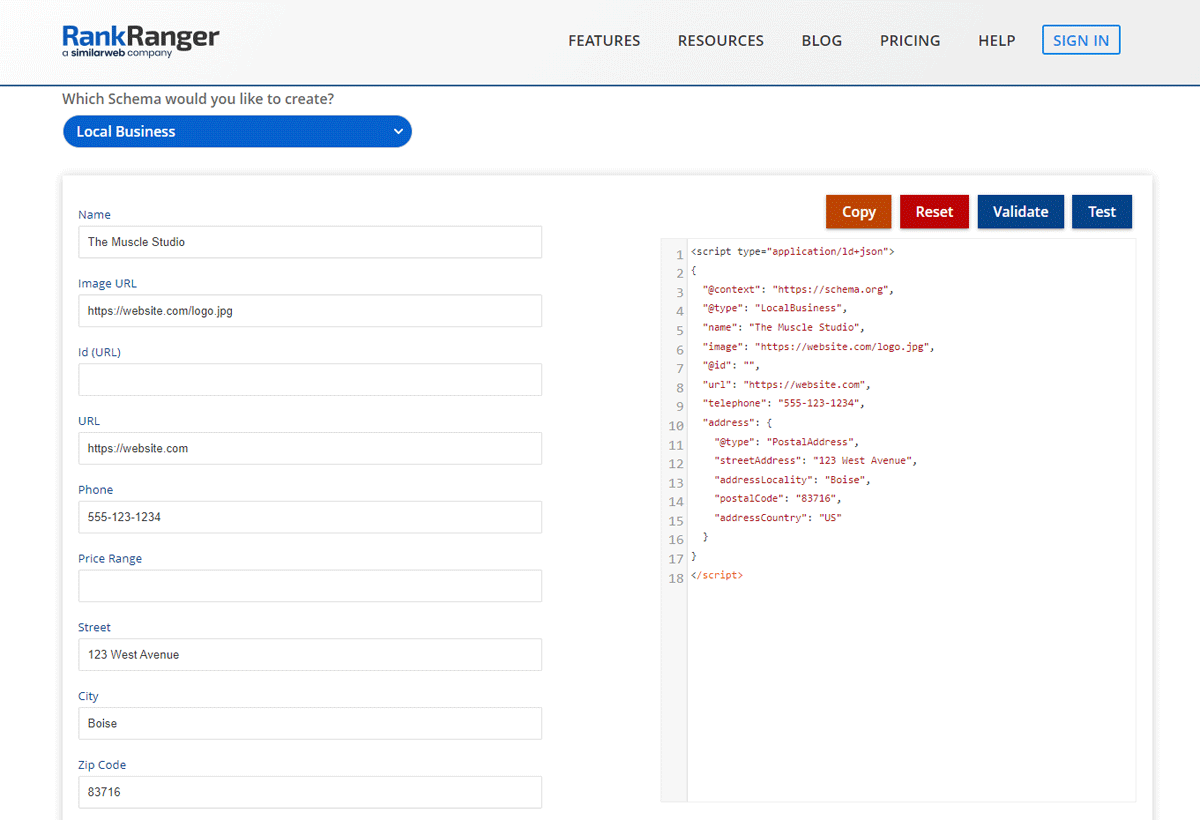
Taking Rank Ranger’s Schema Markup Generator for example, you can choose the “Local Business” option to get the correct fields for NAP and local SEO. Once you’re done using the tool, copy the HTML code and place it in the HTML footer section of your fitness website. If you are using the WordPress content management system, you can install a free plugin like WPCode to gain access to the header and footer code blocks to copy and paste the generated Schema Markup into the HTML.
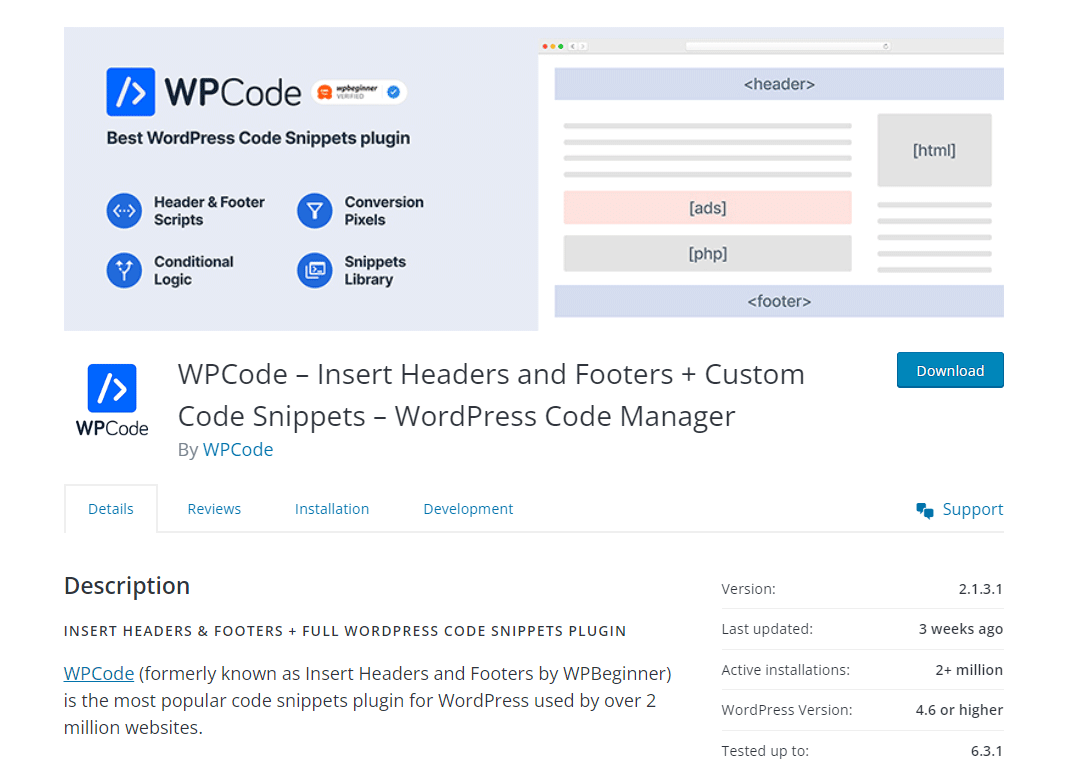
Once you’re done with this step, the foundation of your fitness or gym website will be set up correctly to rank for local searches in Google, Yahoo, and Bing.
5. Build Local Citations for Your Fitness Center or Gym
After your NAP and Schema markup have been added to your fitness website, the final step for improving SEO is to build local citations to further verify your business.
Local citations are a type of crosslinking in SEO that are made up of directory listings with online profiles that include your business name, address, phone number, website URL, and additional information about your fitness or gym business.
Anyone can create a local citation for their organization and many of these directories are free to create a branded profile.
Local citations are important because they not only verify your NAP information is correct but also act as authoritative backlinks for off-site SEO. The more quality backlinks a website receives, the higher its Domain Authority, which is an SEO metric that corresponds to the trust a domain has for Google’s ranking algorithm systems.
Below is a general list of sites you can use to build free and paid local citations for your fitness center or gym. The more local citations you create, the better search engine visibility your business will have on Google, Yahoo, and Bing.
- yelp.com
- foursquare.com
- bbb.org
- local.yahoo.com
- mapquest.com
- yellowpages.com
- angi.com
- here.com
- city-data.com
- manta.com
- tomtom.com
- justlanded.com
- citysearch.com
- merchantcircle.com
- superpages.com
- dandb.com
- us.kompass.com
- factual.com
- local.com
- brownbook.net
- company.com
- yellowbook.com
- chamberofcommerce.com
- infobel.com
- insiderpages.com
- yellowbot.com
- communitywalk.com
- elocal.com
- hotfrog.com
- ezlocal.com
- local.botw.org
- storeboard.com
- tupalo.com
- cybo.com
- ibegin.com
- salespider.com
- showmelocal.com
- neustarlocaleze.biz
- citysquares.com
- n49.com
- cylex.us.com
- yasabe.com
- threebestrated.com
- 2findlocal.com
- bizvotes.com
- b2byellowpages.com
A full list of business directories for building local citations for SEO can be found here: Free Business Listing Sites.
Summary for SEO for Fitness Websites & Gyms
I hope you enjoyed this guide on SEO for fitness websites and gyms.
As you discovered, the basic principle for fitness SEO and gym SEO is to create a well-optimized Google Business Profile for local searches and to verify the NAP information through Schema Markup and third-party business directories. Additionally, optimizing key HTML elements throughout the site and building quality backlinks further helps to improve the ranking value for each keyword on Google’s search engine. By following these SEO strategies, you can boost the chances of your fitness center, gym, or personal trainer site for the keywords that matter most for your business.

SEO Chatter is dedicated to teaching the fundamentals of search engine marketing to help marketers understand how to increase organic website traffic and improve search engine rankings.

